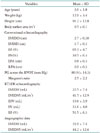1. Riehle TJ, Mahle WT, Parks WJ, Sallee D 3rd, Fyfe DA. Real-time three-dimensional echocardiographic acquisition and quantification of left ventricular indices in children and young adults with congenital heart disease: comparison with magnetic resonance imaging. J Am Soc Echocardiogr. 2008; 21:78–83.
2. Monaghan MJ. Role of real time 3D echocardiography in evaluating the left ventricle. Heart. 2006; 92:131–136.
3. Sugeng L, Weinert L, Lang RM. Left ventricular assessment using real time three dimensional echocardiography. Heart. 2003; 89:Suppl 3. iii29–iii36.
4. Bu L, Munns S, Zhang H, Disterhoft M, Dixon M, Stolpen A, Sonka M, Scholz TD, Mahoney LT, Ge S. Rapid full volume data acquisition by real-time 3-dimensional echocardiography for assessment of left ventricular indexes in children: a validation study compared with magnetic resonance imaging. J Am Soc Echocardiogr. 2005; 18:299–305.
5. Mannaerts HF, Van Der Heide JA, Kamp O, Papavassiliu T, Marcus JT, Beek A, Van Rossum AC, Twisk J, Visser CA. Quantification of left ventricular volumes and ejection fraction using freehand transthoracic three-dimensional echocardiography: comparison with magnetic resonance imaging. J Am Soc Echocardiogr. 2003; 16:101–109.
6. Jenkins C, Bricknell K, Hanekom L, Marwick TH. Reproducibility and accuracy of echocardiographic measurements of left ventricular parameters using real-time three-dimensional echocardiography. J Am Coll Cardiol. 2004; 44:878–886.
7. Sugeng L, Mor-Avi V, Weinert L, Niel J, Ebner C, Steringer-Mascherbauer R, Schmidt F, Galuschky C, Schummers G, Lang RM, Nesser HJ. Quantitative assessment of left ventricular size and function: side-by-side comparison of real-time three-dimensional echocardiography and computed tomography with magnetic resonance reference. Circulation. 2006; 114:654–661.
8. Soriano BD, Hoch M, Ithuralde A, Geva T, Powell AJ, Kussman BD, Graham DA, Tworetzky W, Marx GR. Matrix-array 3-dimensional echocardiographic assessment of volumes, mass, and ejection fraction in young pediatric patients with a functional single ventricle: a comparison study with cardiac magnetic resonance. Circulation. 2008; 117:1842–1848.
9. Iino M, Shiraishi H, Ichihashi K, Hoshina M, Saitoh M, Hirakubo Y, Morimoto Y, Momoi MY. Volume measurement of the left ventricle in children using real-time three-dimensional echocardiography: comparison with ventriculography. J Cardiol. 2007; 49:221–229.
10. Greene DG, Carlisle R, Grant C, Bunnell IL. Estimation of left ventricular volume by one-plane cineangiography. Circulation. 1967; 35:61–69.
11. Graham TP Jr, Faulkner S, Bender H Jr, Wender CM. Hypoplasia of the left ventricle: rare cause of postoperative mortality in tetralogy of Fallot. Am J Cardiol. 1977; 40:454–457.
12. Matsuda H, Hirose H, Nakano S, Kishimoto H, Kato H, Kobayashi J, Miura T, Kato M, Kawashima Y. Age-related changes in right and left ventricular function in tetralogy of Fallot. Jpn Circ J. 1986; 50:1040–1043.
13. Fukuda J, Izumi T, Matsukawa T, Eguchi S. Development of left ventricular muscle in tetralogy of Fallot. Jpn Circ J. 1984; 48:465–473.
14. Heusch A, Rübo J, Krogmann ON, Bönig H, Bourgeois M. Volume measurement of the left ventricle in children with congenital heart defects: 3-dimensional echocardiography versus angiocardiography. Cardiology. 1999; 92:45–52.
15. Kaye HH, Tynan M, Hunter S. Validity of echocardiographic estimates of left ventricular size and performance in infants and children. Br Heart J. 1975; 37:371–375.
16. Lang RM, Badano LP, Tsang W, Adams DH, Agricola E, Buck T, Faletra FF, Franke A, Hung J, de Isla LP, Kamp O, Kasprzak JD, Lancellotti P, Marwick TH, McCulloch ML, Monaghan MJ, Nihoyannopoulos P, Pandian NG, Pellikka PA, Pepi M, Roberson DA, Shernan SK, Shirali GS, Sugeng L, Ten Cate FJ, Vannan MA, Zamorano JL, Zoghbi WA. American Society of Echocardiography. European Association of Echocardiography. EAE/ASE recommendations for image acquisition and display using three-dimensional echocardiography. Eur Heart J Cardiovasc Imaging. 2012; 13:1–46.









 PDF
PDF ePub
ePub Citation
Citation Print
Print


 XML Download
XML Download